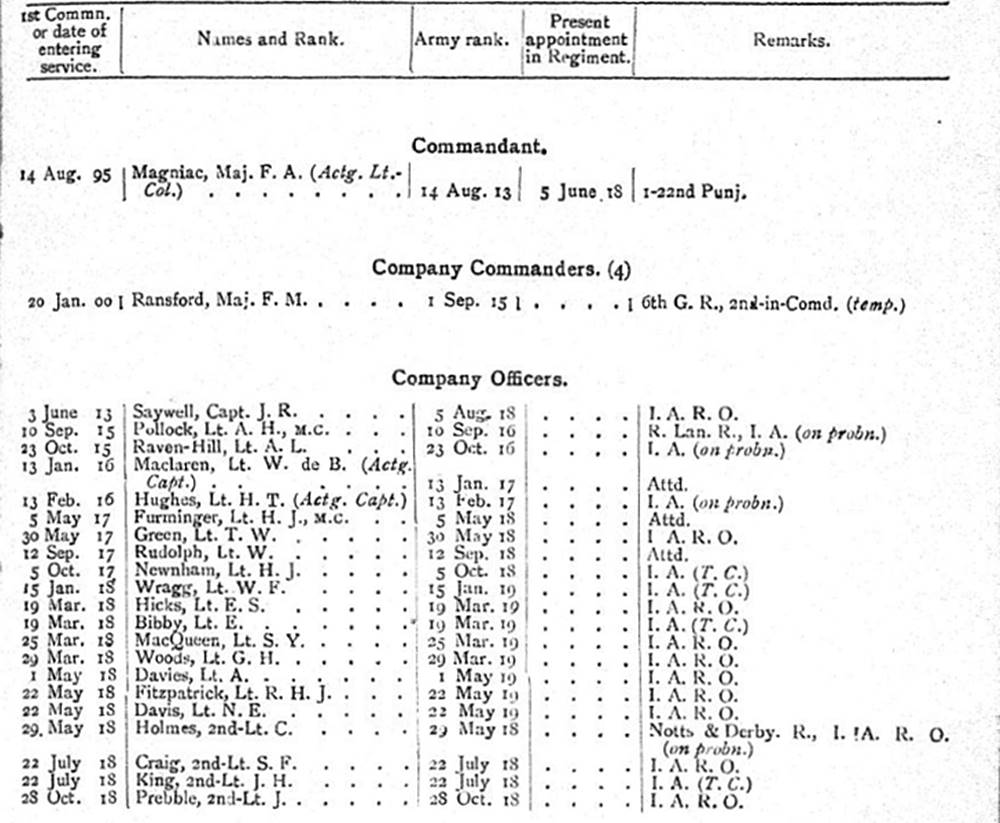This article is about the war-raised 2nd Battalion 26th Punjabis and will help you to research the Battalion and those who served with it during the First World War. I have also written a separate article for what became the 1st Battalion 26th Punjabis on the formation of its second battalion and a series of guides to help you research soldiers who served in the Indian Army:
The 2nd Battalion 26th Punjabis in the First World War
Lineage: The 2nd Battalion 26th Punjabis was formed at Bareilly (Uttar Pradesh, India) on 28 May 1918 and was disbanded on 29 January 1922. For a history of the Regiment’s lineage see my page on the 1st Battalion 26th Punjabis.
Class Composition of Battalion in April 1919: 2 Companies of Punjabi Hindus, 1 Company of Sainis and 1 Company of South Western Punjabi Muslims. July 1921: 1 Company Punjabi Hindus, 1 Company Sikhs, 1 Company Punjabi Muslims and 1 Company of Pathans.
The 2nd Battalion 26th Punjabis was a short-lived Indian infantry battalion formed at Bareilly (Uttar Pradesh, India) on 28 May 1918. Its first commanding officer was Major, acting Lieutenant-Colonel Francis Arthur Magniac who was appointed on 5 June 1918. Magniac was a career Indian Army officer who was transferred from the 22nd Punjabis and had served on the North West Frontier in the years prior to the outbreak of war. The Battalion’s first annual inspection was conducted in March 1919 by Brigadier-General Frederick William Barton Gray who commanded the Bareilly Brigade in which it served:
Drill and rifle exercises good. 595 men fired individual field practices during year ending 28th February. Everything has improved during the cold weather. Discipline not good, but has improved. Discipline not good, but has improved. This battalion is made up of unsatisfactory material. I consider the Punjabi Hindoos are unsuitable for military work, being addicted to intrigue and lacking in any idea of discipline. They have no military instinct and want to leave the Army. They are clever but a feature of their work is that they vary it as they feel inclined. One day working well and again working badly. I think the Hindoos should be disbanded and the Punjabi Mussalmans mixed with men of tried classes. Interior economy satisfactory. The battalion is not up to pre-war standard.
Major-General Oliver Stuart Wood Nugent, commanding the 7th Meerut Division reported the same month:
I do not consider this battalion to be fit for service. I agree on the whole with the views of the General Officer Commanding Bareilly Brigade, but think that a stronger Commanding Officer could have done more with the material and could have averted a serious outbreak resulting in the murder of an Indian Officer of this battalion.
Confidential review reports on Indian Army units, depots, British officers, etc. for 1918-1919: IOR/L/MIL/7/17030
The Battalion joined the North West Frontier Force on 19 May 1919 from Bareilly and served at Kohat, on the North West Frontier. Kohat is now part of Pakistan’s Khyber Pakhtunkhwa province and is located 110 miles west of the capital Islamabad. In the January 1920 and July 1921 editions of the Indian Army List, the Battalion was serving overseas with its Depot at Kirkee (Khadki, Maharashtra). 32 soldiers of the 2nd Battalion 26th Punjabis are commemorated by the Commonwealth War Graves Commission on the Basra and Delhi (India Gate) Memorials. The Battalion was disbanded on 29 January 1922.
The extract below was taken from the July 1919 Indian Army List and recorded the officers serving with the Battalion. Only twenty-three of the British officers had been commissioned prior to the outbreak of war. This was typical of a later war-raised battalion, with the officers drawn from those with temporary commissions or from the Indian Army Reserve of Officers.
War Diaries of the 2nd Battalion 26th Punjabis
Unfortunately, there are no war diaries for the 2nd Battalion 26th Punjabis.
Further Sources for the 2nd Battalion 26th Punjabis
For information regarding British and Indian officers who served with the 2nd Battalion 26th Punjabis the Indian Army List should be consulted. The Confidential Reports for the Battalion are held at the British Library: Confidential Reports on Regiments etc. These reports also contain the annual reports of the British officers serving with the Battalion.

